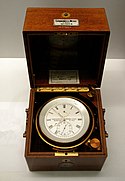Námořní chronometr
Námořní chronometr jsou mechanické hodiny umístěné do zvláštního pláště neustále udržujícího mechanismus hodinek v horizontální poloze (poprvé ho sestrojil/vynalezl John Harrison v roce 1759). Používal se pro stanovení zeměpisné délky a šířky polohy lodi v oceánu. Zvláštní plášť odstraňuje vliv teploty a gravitace na přesnost chodu hodinového mechanismu.
Galerie
Vyrobil Jeremy Thacker, používá kardanův závěs a vakuum ve zvonové nádobě.
Chronometr H1 vyrobil John Harrison v roce 1735.
Náčrt chronometru H4 z roku 1761, publikováno v The principles of Mr Harrison's time-keeper v roce 1767.[1]
- (c) Rama, CC BY-SA 3.0 fr
Námořní chronometr číslo 3, vyrobil Ferdinand Berthoud v roce 1763.
Námořní chronometr z roku 1766 vyrobil Pierre Le Roy, vyfotografován v Musée des arts et métiers, Paříž, Francie.
Chronometr H5, John Harrison, 1772.
Chronometr č. 24, Ferdinand Berthoud (1782), Musée des arts et métiers, Paříž, Francie.
Reference
Externí odkazy
 Obrázky, zvuky či videa k tématu Námořní chronometr ve Wikimedia Commons
Obrázky, zvuky či videa k tématu Námořní chronometr ve Wikimedia Commons
Média použitá na této stránce
Autor: User:Ktr101, Licence: CC BY-SA 4.0
Marine Chronometer #2299 made by Charles Frodsham of London, circa 1844 – 1860. It was later modified to include a telegraph break circuit by William Bond and Son of Boston. From the Ladd Observatory collection.
Autor: Phantom Photographer, Licence: CC BY-SA 3.0
John Harrison's H1 marine chronometer. It took Harrison about five years to develop this chronometer. Its sea trial was in 1735 on HMS Centurion to Lisbon and HMS Orford returning to England. It weighs 34 kilograms (75 lb) and was originally housed in a glazed wooden case about 120 centimetres (3.9 ft) in each dimension.
Instead of a pendulum, it employs a pair of rocking bars with balls on the end and constrained with helical springs. The equal and opposite movement of these bars was less susceptible to being affected by a ships movement than a pendulum would be. Harrison's grasshopper escapement connects the bars with the rest of the mechanism. Some of the cog wheels are of wood which has self-lubricating properties. Gridirons provide temperature compensation by modifying the effective length of the helical springs.
For this invention Harrison received £250 (compared with the £20,000 offered for a full solution) from the Board of Longitude.
Harrison called it a "timekeeper".
The bar-balances like elongated dumbells do not run in conventional bearings. Instead they roll on pairs of plates set at 45° to the vertical and at 90° to each other. These plates, which only move through very short distances are on the ends of long arms pivoted near the bottom of the instrument. The counterweights to these arms are the brass knobs looking like control knobs at the very bottom.
This and other devices mean that the clock requires no lubrication.
- Harrison Jonathan Betts National Maritime Museum, Greenwich, 2007
- Ref: The Illustrated Longitude, Dava Sobel and William J. H. Andrews, Fourth Estate, London, 1998.
Better images: pixgood and my-time-machines.
Shot without flash, 800 ASA setting.Henry_Sully_clock_with_escapement_and_suspension_mechanism
Chronometer_of_Jeremy_Thacker
Photo taken in the Musée des Arts et Métiers
Harrison_H4 clock_in The principles of Mr Harrison's time-keeper 1767
(c) Racklever na projektu Wikipedie v jazyce angličtina, CC BY 2.5
John Harrison's famous chronometer





















